Here's Chicago! The City of Dreams |
Read more at in70mm.com The 70mm Newsletter |
| Written by: Kyle Westphal and Julian Antos, chicagofilmsociety.org | Date: 30.08.2022 |
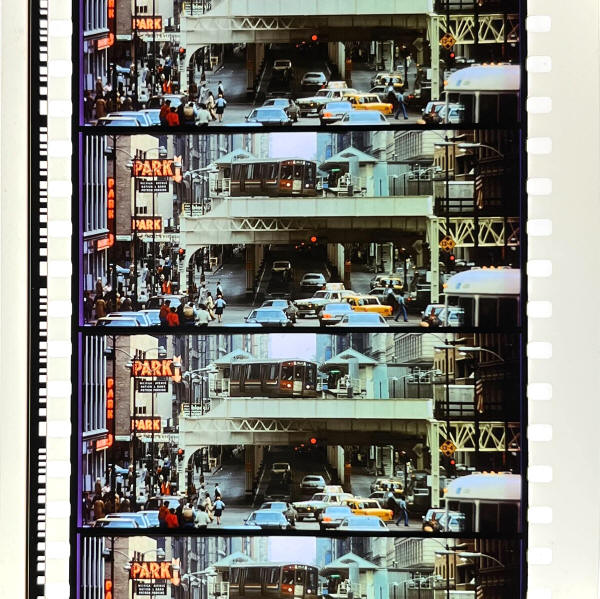 Here’s
Chicago! features breathtaking shots of the city and “Where’s Waldo” scale
opportunities for watching the inhabitants. Frame
grab from "Here's Chicago. The City of Dreams" Here’s
Chicago! features breathtaking shots of the city and “Where’s Waldo” scale
opportunities for watching the inhabitants. Frame
grab from "Here's Chicago. The City of Dreams"Chicago’s Water Tower Pumping Station at 801 N. Michigan Avenue is an ornate Gothic building completed in 1869. One of the only structures on the City’s North Side to survive the Great Chicago Fire of 1871, the Pumping Station became a symbol of civic resilience and was inducted into the National Register of Historic Places in 1975. Less than a decade after that designation, the Pumping Station would improbably become the site of Here’s Chicago!, a short-lived but controversial multimedia tourist attraction that included The City of Dreams, a rare 70mm entry in that most cut-and-dried of genres, the municipal travelogue. • Go to European Premiere at the 16. Todd-AO 70mm-Festival 2022 The brainchild of real estate magnate William F. Hartnett, Jr. (1924 - 2013), who had developed United Nations Plaza in New York and Lake Point Tower in Chicago (the world’s tallest apartment building upon its opening), Here’s Chicago! was promoted as a public-private partnership that would revitalize a historic structure. Although the Pumping Station still provided water to 400,000 Chicagoans, it had been closed to the public for five decades, even as the vibrant Magnificent Mile shopping district had grown up around it. Hartnett approached the City Council Finance Committee in June 1982 about his plan to rent the Pumping Station, promising millions in private investment if the City granted a 20-year lease. The proposal had seemingly appeared out of the blue, prompting several aldermen [elected supervisors -- Ed.] to suspect that the exhibition was intended as a stealth advertisement for Mayor Jane Byrne’s 1983 re-election campaign. By November 1982, the political considerations had been ironed out, with an announcement that camera crews would be filming around the city and interviewing everyday Chicagoans. The City Council agreed to rent the Pumping Station for $42,000 a year, plus a steadily rising share of net profits, which would eventually top out at 50%. Hartnett kept his end of the bargain and raised some $3.5 million from 32 investors. The plan for Here’s Chicago! included a gift shop, a rotating group of temporary exhibits, and two permanent audiovisual centerpieces: Heartbeat Chicago and The City of Dreams, both spearheaded by marketing and communications consultant Ted Hearne. A quadraphonic cacophony of civic pride, Heartbeat Chicago was a 20-minute slideshow utilizing 2,500 images and 63 projectors, with snippets of audio interviews backed by Chicago Symphony Orchestra’s performance of an original composition from John Tatgenhorst. The show was culled from over 40,000 photographs, largely the work of Bob Frerck, Brian Seed, and Dan Morrill. The interviews drew upon the city’s most reluctant boosters - its citizens. |
More in 70mm reading: European Premiere at the 16. Todd-AO 70mm-Festival 2022 Various Large format and 70mm Films in70mm.com's Library Presented on the big screen in 7OMM Peripheral Vision, Scopes, Dimensions and Panoramas Schauburg Cinerama, Karlsruhe, Germany. Home of The Todd-AO Festival |
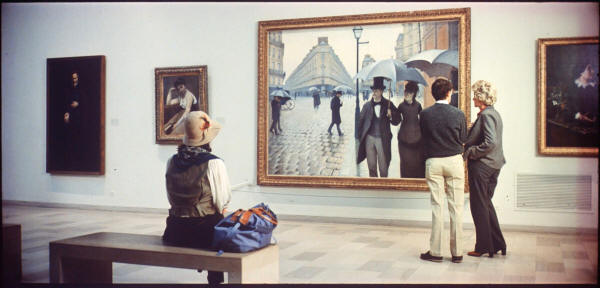 Frame
grab from "Here's Chicago. The City of Dreams" Frame
grab from "Here's Chicago. The City of Dreams"
Hearne’s crew exposed 32,000 feet of 65mm negative for The City of Dreams, with
ample aerial footage from around the city. Chicago’s architecture receives pride
of place. A voiceover breezily acknowledges the wonders of Rome and Paris, only
to aver, “If you want to see the 20th century, you come to Chicago, because
these are the monuments of our time.” (The film cheats a little by including the
striking Bahá'í House of Worship in suburban Wilmette in its architectural honor
roll.) The film closes with a photomontage that recounts the city’s history. |
|
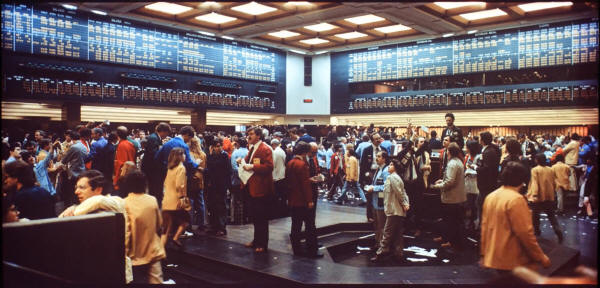 Frame
grab from "Here's Chicago. The City of Dreams" Frame
grab from "Here's Chicago. The City of Dreams"The legacy of The City of Dreams is inevitably tied up in the broader project of Here’s Chicago!, a profit-minded but heartfelt tribute to a city that scarcely returned the favor. The exhibit opened on 17 May 1983, complete with a woman dressed as Mrs. O’Leary promenading down the Magnificent Mile with her cow, the alleged instigator of the Great Chicago Fire. Running continuously every half hour from 10 in the morning to 10:30 at night, Here’s Chicago! initially attracted sparse attendance and mocking coverage in the local press. Alfred Borcover, the Chicago Tribune’s travel editor, paid a visit a month after the opening, touring the pump, the Great Fire-themed Hall of Flames, and the Cheerie O’Leary Gift Emporium, which he summed up as
Of Heartbeat
Chicago and The City of Dreams, Borcover observed: |
|
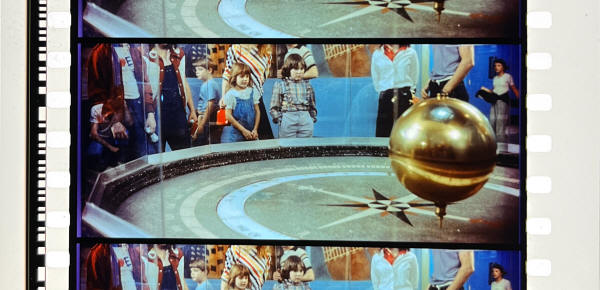 Frame
grab from "Here's Chicago. The City of Dreams" Frame
grab from "Here's Chicago. The City of Dreams"But newfound civic respectability only went so far. When Hartnett and Hearne were barnstorming the city in 1982, they predicted Here’s Chicago! would attract 1.5 million visitors annually. By 1988, they were closing in on two million visitors in total. Journalist Rick Kogan visited Here’s Chicago! that January and devoted half his Tribune column to a novelty “where most Chicagoans have never been.” Hartnett acceded to the new reality in a 1990 interview.
It wasn’t enough. In 1993, the City moved to revoke the 20-year lease, citing
$400,000 in accumulated real estate taxes and interest penalties. Here’s
Chicago! claimed breach of contract and sued the City for $3 million. After a
Cook County judge threw out the claim and awarded petitioners $31,626, Here’s
Chicago! closed in March 1996. On 18 May 1996, Here’s Chicago! auctioned off its
remaining assets, including a fog machine, an Audiotronic Abraham Lincoln robot,
a popcorn popper, the 100 Years After the Fire mural, and the 35mm/70mm Kinoton
projectors that once ran The City of Dreams twenty-five times a day. |
|
"The City of Dreams" Credits |
|
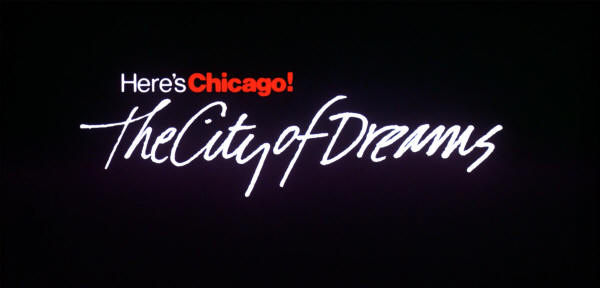 Frame
grab from "Here's Chicago. The City of Dreams" Frame
grab from "Here's Chicago. The City of Dreams"This film is dedicated to the people of Chicago whose vision and spirit have made this project possible "Heartbeat Chicago" and "The City of Dreams" were produced and directed by Ted Hearne. Here's Chicago Productions. Excecutive Producers: William F. Hartnett, Jr. & Ted Hearne. Here's Chicago! The City of Dreams (1983) has been Preserved by the Chicago Film Society. 70mm scan and digital restoration: Helge Bernhardt. Project coordinators: Julian Antos, Kyle Westphal. 65mm/70mm Laboratory Services by Andrew Oran. Special thanks to Helge Bernhardt, Nicholas Bergh, Paul Rayton, Mike Quintero, Andrew Oran, and Iver Burke. Project Funding: National Film Preservation Foundation. Digital soundtrack: Iventure Studios. |
|
About the Restoration and new 70mm Print |
|
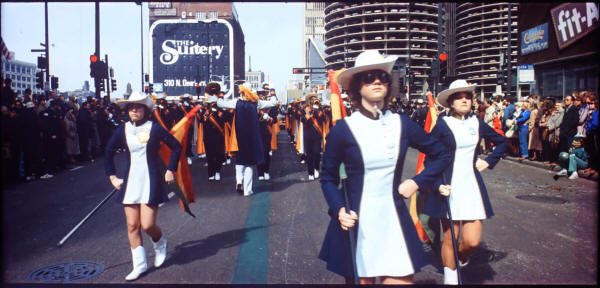 Frame
grab from "Here's Chicago. The City of Dreams" Frame
grab from "Here's Chicago. The City of Dreams"The original negative of Here’s Chicago! The City of Dreams is not known to survive. A 70mm print in the collection of the Chicago Film Society (struck in 1988 on low fade LPP stock, with a six-channel magnetic soundtrack) represents the only copy known to be extant. This 70mm print was scanned in 6K by Helge Bernhardt, who also performed extensive digital restoration and color correction. The restored version was recorded back to 65mm negative at FotoKem. Audio restoration was performed by Inventure and serves as the basis for the new DTS soundtrack, configured and optimized for playback on modern 70mm exhibition equipment. New 70mm prints were struck at FotoKem. Two 70mm prints were made, one for long term archiving and the other for general distribution. Funding provided by National Film Preservation Foundation. Special Thanks: Helge Bernhardt, Nicholas Bergh, Paul Rayton, Mike Quintero, Andrew Oran, and Iver Burke. 23. June 2022 World premiere, Music Box, Chicago, USA 2. October 2022 European premiere, Schauburg Cinerama, Karlsruhe, Germany |
|
| Go: back - top - back issues - news index Updated 22-01-25 |
